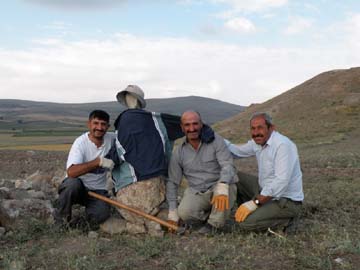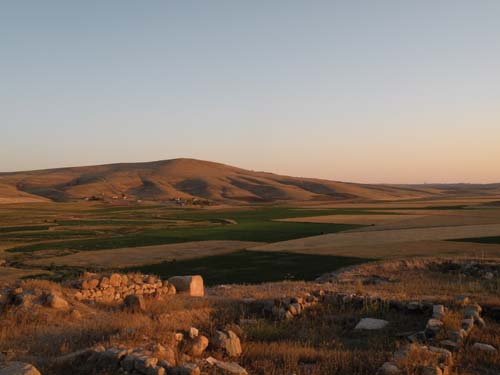 |
 |
| current issue |  |
past issues |  |
send a letter/news |  |
address update |  |
advertise |  |
about us |  |
alumni home |
Features
Buried TreasureWhat a UNH professor and his students find out about ancient civilizations in Turkey may tell us more about our own.
by Barbara Walsh '81
The air is mercifully cool when they arrive at the excavation site outside the small Turkish village. The smells of ripening wheat, grazing sheep and the musky scent of earth greet the workers just after dawn. The wind, which will later swirl dust into their eyes and ears and upon their faces, is still as they begin to dig. Carefully, precisely, each of them—UNH history professor Gregory McMahon and his four UNH students—search for clues that will link them to civilizations dating back to 4,000 B.C.
 FLINTY FELLOW: Turkish workers posing with a stone version of a snowman, built with boulders pulled from the Byzantine trench, are from left, Hasim, Selattin and Hayati. |
Here on Cadir Hoeyuek, a mound that rises 100 feet, they will hunt for primitive pottery, bones and tools, foundations of homes, towns and temples—the remnants of people who lived here long ago. For five weeks, they will work with 14 other American and Canadian students, scholars and archaeologists, toiling 10-hour days in blistering sun and blinding dust, collecting, archiving and recording ancient treasures and trash left behind.
"It's one thing to study ancient history, but the thrill is getting out there," says T. Brice Pearce '09G, who is pursuing a master's degree in history. "The idea that you could be the first human being to see, touch or smell something that is 3,000 years old—it's almost like you've traveled back in time."
For McMahon, returning to the central Turkish village of Peyniryemez is equal parts reunion and homecoming. Since 1994, he has come to Cadir Hoeyuek to work with colleagues who share his passion for people and things long forgotten. "This is my calling, studying the past, other people's culture, by walking their ground, digging up their cities," he says. "The closer we can get to people in antiquity, the more we learn about modern society. Everything we do today—in our religion, our economy—is based on the origins of our civilization."
 |
Like most archaeological mounds in Turkey, Cadir Hoeyuek was created by civilizations and communities that were destroyed and then rebuilt one on top of the other. "If you level off and rebuild for 5,000 years, you end up with a mound that is elevated," McMahon explains. "The abandoned towns are then covered with thousands of years of windblown erosion, which fills in every nook and cranny."
Page: 1 2 3 Next >Easy to print version
blog comments powered by Disqus
